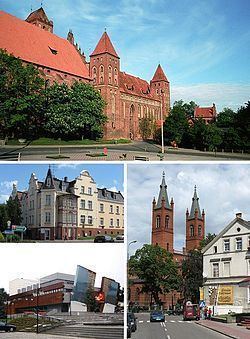Gmina Kwidzyn (urban gmina) Town rights 1233 Area 21.82 km² Population 37,814 (2006) | County Kwidzyn County Established 11th century Elevation 42 m (138 ft) Local time Sunday 1:49 PM | |
 | ||
Weather 5°C, Wind NW at 13 km/h, 66% Humidity Points of interest Kwidzyn Castle, Zamek w Kwidzynie, Rezerwat przyrody Kwidzyńs | ||
Kwidzyn ([ˈkfʲid͡zɨn]; Latin: Quedin; German: Marienwerder; Prussian: Kwēdina) is a town in northern Poland on the Liwa river in the Powiśle (right bank of Vistula) region, with 40,008 inhabitants (2004). It has been a part of the Pomeranian Voivodeship since 1999, and was previously in the Elbląg Voivodeship (1975–1998). It is the capital of Kwidzyn County.
Contents
- Map of Kwidzyn Poland
- History
- Geography
- Points of interest
- Economy
- People
- Burials
- Twin towns sister cities
- References
Map of Kwidzyn, Poland
History
The Teutonic Knights founded an Ordensburg castle in 1232 and a town the following year. In 1243 the Bishopric of Pomesania received both the town and the castle of Marienwerder (German for "Mary's ait") from the Teutonic Order as fiefs, and the settlement became the seat of the Bishops of Pomesania within Prussia. The town was populated with Masurian settlers. Werner von Orseln, who died in Marienburg (Malbork) in 1330, was buried in the cathedral of the town. St. Dorothea of Montau lived here from 1391 until her death in 1394; pilgrims would later come to pray in the town at her shrine. The rebellious Prussian Confederation was founded in the town on March 14, 1440. In 1466, the town became a Polish fief together with the remainder of the monastic state of the Teutonic Knights after their defeat in the Thirteen Years' War.
It became part of the Duchy of Prussia, a fief of Poland, upon its creation in 1525. The duchy was inherited by the House of Hohenzollern in 1618 and was elevated to the Kingdom of Prussia in 1701. The town became the capital of the District of Marienwerder. When after the First Partition of Poland, resulting in the re-unification of Prussia, the new Prussian Province of West Prussia was founded, Marienwerder was taken out of the Province of East Prussia and integrated into West Prussia of which it became the administrative seat. The town and district were included within the government region of Marienwerder after the Napoleonic Wars.
In 1885 the town had 8,079 mostly Lutheran inhabitants, many of whose trades were connected with the manufacturing of sugar, vinegar, and machines. Other trades were brewing, dairy farming, and fruit-growing. According to official statistics, c. 1910, 35.7% of the county's population was Polish.
After World War I most of West Prussia was incorporated into the Polish Second Republic. The treaty of Versailles required the inhabitants of East Prussia to vote in the East Prussian plebiscite to determine if the town would remain in Germany as part of East Prussia or join Poland; the vote was largely boycotted by ethnic Poles amid persecution of Polish activists by the German side.
On November 10, 1937, when the Nazi regime was already in power in Germany, a Polish private high school was opened in Marienwerder, which was closed down by force on August 25, 1939.
On 30 January 1945 during World War II, the town was captured by the Soviet Red Army. Red Army established a war hospital in the town for 20,000 people. The town's old center was burned by Soviet soldiers.
After World War II the region was placed under Polish administration by the Potsdam Agreement under territorial changes demanded by the Soviet Union. The majority of town's population, being Germans fled or were expelled and replaced with Poles, some of whom expelled from the Polish areas annexed by the Soviet Union or Ukrainians forced to settle in the area through Operation Vistula in 1947. Burned parts of the town's old center were dismantled to provide material for the rebuilding of Warsaw after its destruction in the Warsaw Uprising.
Geography
Kwidzyn is located on the east bank of river Vistula, approximately 70 kilometres (43 miles) south of Gdańsk and 145 kilometres (90 miles) south-west of Kaliningrad.
Points of interest
Kwidzyn contains the partially ruined 14th century Brick Gothic Ordensburg castle of the Teutonic Order, namely the Bishops of Pomesania within the Order. Connected to the castle to the east is a large cathedral (built 1343-1384) containing the tombs of the bishops as well those of three Grand Masters of the Teutonic Knights. The literally outstanding feature of the castle is a sewer tower which is connected to it by a bridge. The tower used to be placed at the river which has changed its course since, leaving it on dry land.
The town also has a Catholic church and a cathedral-castle presently used for the museum of Lower Powiśle. Other sights include the appellate court for Kwidzyn County, a new town hall, and government buildings.
Economy
A branch of the company International Paper is located in Kwidzyn, as is the Kwidzyn School of Management. The second biggest employer is Jabil which is one of world leading EMS (Electronics manufacturing services) companies. The city has a lower than national average crime and unemployment rates when compared to the average rate in Poland average. Success in this field was gained through high level of sport programs for youths. Programs such as MMTS Kwidzyn (handball) or MTS Basket Kwidzyn are the best examples of this.
People
Burials
Twin towns — sister cities
Kwidzyn is twinned with:
